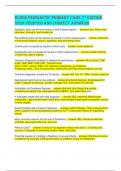BURNS PEDRIACTIC PRIMARY CARE 7TH EDITION
2020 VERIFIED AND CORRECT ANSWERS
Epigastric pain can be from issues in which areas/organs: - -answer-Liver, biliary tree,
pancreas, stomach, and duodenum
Periumbilical pain can be caused by issues in which areas/organs: - -answer-distal end
of the small intestine, cecum, appendix, and ascending colon
Colonic pain is caused by issues in which area - -answer-Lower abdomin
Suprapubic pain is caused by issues in which organs/area? - -answer-distal intestine,
urinary tract, pelvic organs,
Common Diagnositc studies for abdominal pain/issues - -answer-UA & culture, CBC
w/diff, CMP,BMP, ESR,CRP, Thyroid Panel
Stool= O&P, culture, WBC, pH, reducing substances, fat collection
Pregnancy tests, Urine for gonorrhea, chlamydia and Pap smear/Vaginal cultures
Common diagnostic studies for GI issues - -answer-XR, US, CT, MRI, nuclear medicine
Specialized tests that can be ordered - -answer-Duodenal Aspirate, Esophageal pH
probe, Capsule endoscopy, breath hydrogen test, and sweat chloride test
Indications for Duodenal Aspirate - -answer-diarrhea from things like giardia,
unintentional weight loss, dyspepsia(reflux/GERD), and abdominal pain
A hydrogen breath test can help diagnose: - -answer-IBS, Intestinal Methanogen
overgrowth, rapid small bowel transit time, and possibly esophageal and gastric cancer
in early stages.
Sweat chloride test is used to diagnose: - -answer-Cystic Fibrosis. This is usually done
when a patient is having digestive problems, & FTT along with history of respiratory
issues.
Most common reasons for the use of Probiotics - -answer-IBS, Infectious diarrhea,
antibiotic associated diarrhea, and colic
What is Colic? - -answer-Crying for no apparent reason that lasts > 3 hrs/day and
occurs > 3 days/wk in otherwise healthy infant <3months
Potential causes of vomiting in Newborn or young infants - -answer-infectious process,
congenital GI anomaly, CNS abnormality, or newborn errors of metabolism
, Potential causes of vomiting in Infants or young children - -answer-Gastroenteritis,
GERD, milk/soy protien allergies, pyloric stenosis or obstructive lesion, inborn errors of
metabolism, intussusception, child abuse, &intracranial mass
Potential causes of vomiting in older children and adolescents - -answer-Gastroenteritis,
systemic illness, CNS (cyclic vomiting syndrome, abdominal migraine, meningitis, brain
tumor), intussusception, rumination, superior mesenteric artery syndrome, pregnancy
_________ is one of the most common symptoms in childhood. - -answer-vomiting
Non-bilious vomiting is generally caused by: - -answer-infection, inflammation, and
metabolic, neurologic, or psychological problems.
An ------- -------- generally causes causes bilious vomiting. - -answer-obstructive lesion
Bloody vomit comes from: - -answer-active bleeding in the upper GI tract (gastritis,
peptic ulcer disease)
Rumination Syndrome - -answer-a condition in which people repeatedly and
unintentionally spit up (regurgitate) undigested or partially digested food from the
stomach, rechew it, and then either reswallow it or spit it out. Usually seen in infants
under 1 year of age.
What is superior mesenteric artery syndrome? - -answer-a digestive condition that
occurs when the duodenum (the first part of the small intestine) is compressed between
two arteries (the aorta and the superior mesenteric artery). This compression causes
partial or complete blockage of the duodenum.
Clinical signs of dehydration - -answer-Capillary refill >2 seconds, slow rebound on skin
turgor, & tachypnea. Sunken eyes, Dry mucous membranes, presence of tears,
decreased UOP.
Stages of dehydration minimal or none: - -answer-<3% loss of body weight, assessment
wnl
Stages of dehydration Mild to Moderate: - -answer-3%-9% loss of body weight, fatigued
or restless, irritable, thirsty eager to drink, eyes slightly sunken, decreased tears, dry
mouth, skin recoil <2sec, prolonged cap refill, cool extremities, decreased UOP
Stages of dehydration severe: - -answer->9% loss of body weight, lethargic, apathetic,
unconscious, unable to drink, tachycardia, bradycardia in most severe cases, weak
thready or impalpable pulses, deep breathing, deeply sunken eyes, absent tears,
parched mouth, recoil of skin >2 seconds or tenting, prolonged or minimal cap refill,
cold, mottled cyanotic extremities, minimal or no UOP.




